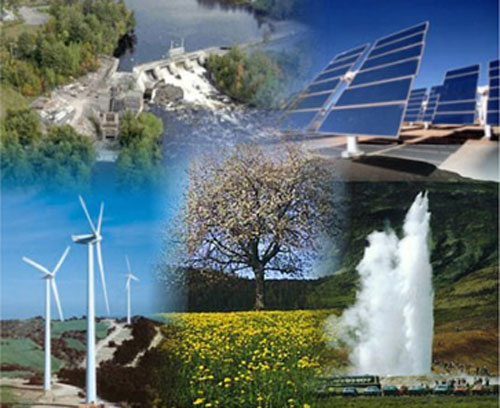Can the whole planet really get 100 percent of its energy from renewables in just two decades?
Yes, according to new research, and for cheaper than coal.
But how exactly? The answer lies in scaling up three categories of existing clean energy technologies – wind, solar and water – and global political will.
The paper, “A Plan to Power 100 Percent of the Planet with Renewables,” was published in the November issue of Scientific American. The magazine is no foreigner to printing clean energy moon shots. In December 2007, it grabbed global headlines for its solar grand plan, a roadmap for getting 69 percent of America’s electricity from sunlight by 2050.
This latest piece is the work of Stanford civil and environmental engineering Professor Mark Z. Jacobson and University of California-Davis researcher Mark Delucchi. Its main conclusion should sound familiar to the clean energy faithful: A fossil-powered future is no longer necessary and may not even make economic sense.
For one, say the authors, the technologies needed for 100 percent clean power are already working (or close to working) today. Two, the cost of generating and transmitting these renewables would be less than the projected cost per kilowatt-hour for fossil-fuel and nuclear power. And three, a massive shift from conventional to clean power would lead to a 30 percent decrease in global power demand.
According to the research, the world will need 16.9 terrawatts (TW, or 1 trillion watts) of power by 2030, up from 12.5 TW today. Meeting that with coal alone would require 13,000 new facilities.
Under the Jacobson-Delucchi plan, the total amount of energy needed worldwide would drop to 11.5 TW.
Why? In most cases, electrification is a more efficient way to use energy than combustion, the authors write. Take electric cars:
“Only 17 to 20 percent of the energy in gasoline is used to move a vehicle (the rest is wasted as heat), whereas 75 to 86 percent of the electricity delivered to an electric vehicle goes into motion.”
Still, the up-front costs of virtually eliminating greenhouse gas emissions through new energy would be enormous. Construction costs “might be” $100 trillion worldwide over 20 years, the authors admit. And that’s not including the costs of transmission.
They claim the investment would be paid back through the sale of electricity and energy. And they make the case, as many others have before them, that a business-as-usual future would be costlier in the long run: $10 trillion in thousands of new coal plants, not to mention the tens of trillions in health, environmental, security and other “externality” costs.
But the world has its work cut out for it. Currently, less than one percent of clean technologies needed for a 100 percent scenario are in place.
Here’s the plan:
Wind: 51% of power needs. This would require 3.8 million large new wind turbines worldwide. Currently, less than 1% of that amount is installed.
Solar: 40% of power needs. This calls for 89,000 photovoltaic installations and concentrating solar power farms, all at 300 megawatts each. Like wind, the world is at less than 1% of that target.
Water: 9% of power needs. This would require the deployment of numerous “mature water-related” technologies, including 490,000 tidal turbines, 5,350 geothermal plants and 900 hydroelectric plants. For hydroelectric, the world has 70 percent in place. For geothermal, there are less than 2% of the needed facilities installed, and turbines, less than 1%.
The authors assume that most fossil fuel transportation can be replaced by battery and fuel-cell vehicles. They also say that resource availability for the plan isn’t a problem.
“Supplies of wind and solar energy on accessible land dwarf the energy consumed by people around the globe.”The amount of tappable wind is about 40 to 85 TW. For solar it’s 580 TW. Currently, the world generates only 0.02 TW of wind power and 0.008 TW of solar.
Here’s what governments must do:
• Eliminate fossil fuel subsidies, such as tax benefits for their exploration and extraction.
• Enact feed-in tariff (FIT) programs that cover the difference between generation costs and electricity prices.
• Tax fossil fuels or their use to reflect environmental damages.
• End “misguided promotion of alternatives” that are less desirable than wind, solar and water, such as farm and production subsidies for biofuels.
• Invest in long-distance, robust transmission systems that can carry large quantities of clean power from remote regions to consumption centers.
• Build smart grid systems that reduces consumer demand during peak usage periods.
The main obstacle is the political will to implement these policies, the report claims. The second biggest hurdle is the shortage of vital materials. “Countries such as the U.S. could be trading dependence on Middle Eastern oil for dependence on Far Eastern metals. Manufacturers are moving toward gearless turbines, however, so that limitation may become moot.”
Some materials are scarce, while others are subject to price manipulation. Rare-earth materials are the biggest looming problem, namely neodymium used in wind turbine gear boxes. The material is concentrated in China. Beware, say the authors:
Photovoltaic solar cells also rely on potentially scarce materials, such as amorphous or crystalline silicon, cadmium telluride, and copper indium selenide and sulfide. So do next-generation cars. There are: lithium for batteries, platinum for fuel cells and earth metals for electric cars.
While none of these hang ups are “insurmountable,” even Jacobson and Delucchi recognize their plan is theoretical at this point. They close with a more realistic goal for the planet: 25 percent clean energy by 2025, and 100 percent by 2040.
“With sensible policies, nations could set a goal of generating 25 percent of their new energy supply with WWS sources in 10 to 15 years and almost 100 percent of new supply in 20 to 30 years. With extremely aggressive policies, all existing fossil-fuel capacity could theoretically be retired and replaced in the same period, but with more modest and likely policies full replacement may take 40 to 50 years.”








